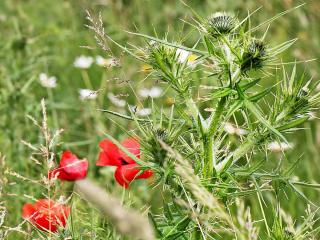

Thistle is actually a generic name that includes many different perennials which have flowers that are addicted to needles!
Summary of key thistle facts
Name – Eryngium planus or Echinops ritro
Family – Apiaceae (parsley family)
Type – perennial
Height – 12 to 32 inches (30 to 80 cm)
Exposure – full sun
Soil – ordinary, well drained
Foliage: deciduous – Flowering: June to September
At the heart of a flower bed, it adds an aesthetic touch and a hint of wildflower that is very interesting. Elegant in dry flower compositions.
Favor planting in fall with a mix of garden soil and soil mix.

Being a very easy plant to care for, thistle requires practically no care at all.
But if you’re really craving for details about thistles, a secret tip is that removing dead flowers whenever they wilt away will trigger new blooms. Staking the stems of taller varieties will ensure that the stems won’t fold under the weight of the flowers and/or gusts of wind.
This perennial has leaves and flowers that are a distinctive silver blue color, long stems and thorny leaves that you don’t want to embrace…
It bears round, needle-studded flowers that will open very well when cut and placed in a vase. They’ll lend your bouquet that special wildflower touch, especially for dried flowers.
Here are a few interesting thistle species:
Apart from its beautiful violet blue flowers, some blue thistle species are also edible! The roots can be dug out and eaten. Thistle also is used for medicinal purposes against rheumatism and kidney stones.
This plant needs a lot of water. To avoid spending your entire summer watering it, add mulch in spring.